by: Contact Archeology Inc. (CAI)
February 2024
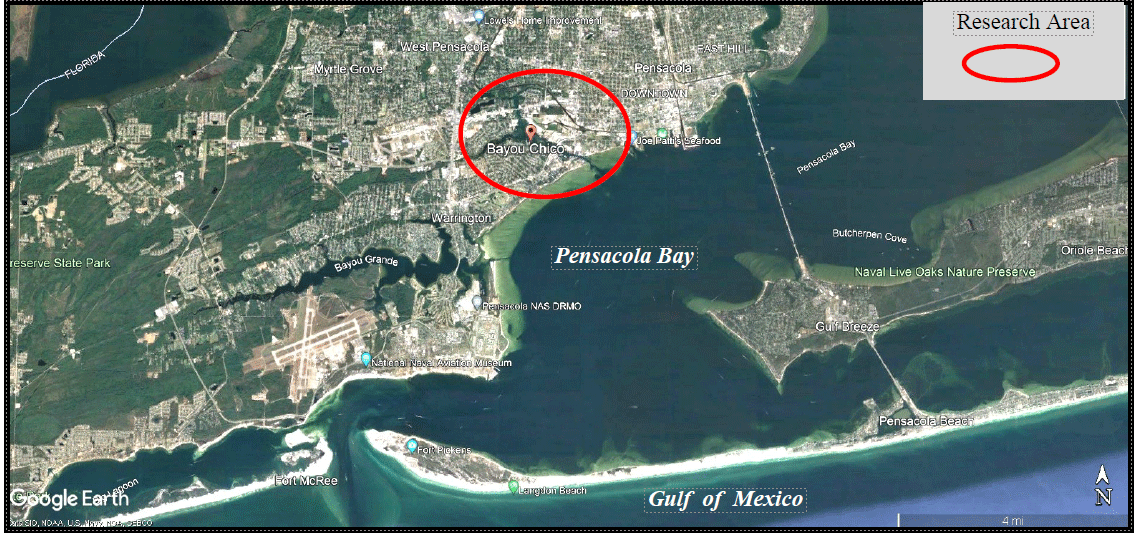
Gulf of Mexico, Pensacola Bay Research Area
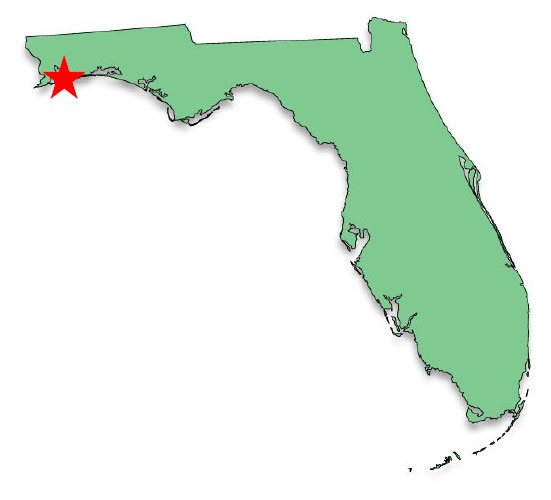 Introduction
Introduction
Contact Archeology Inc. (CAI) presents this article regarding our research on Bayou Chico as an introduction to our historical and archeological research in the bayou area. The article is meant to acquaint the reader with the location of the bayou, the current environment, a photo tour of the area, a sample of our excavation
techniques both terrestrial and aquatic, followed by our ongoing research plans. It is not meant to be a technical report. That is planned for later. To produce a technical report we need more archeological excavations and we need more support funds. CAI is primarily focusing our archeological research on the historic period of the European and American presence on Bayou Chico during the periods of the 1500s, 1600s, 1700s, and the early1800s. Bayou Chico is a tributary of Florida’s Pensacola Bay. The bayou is fed by freshwater springs at its headwaters, more so in the past. That fact along with relatively deep water and the close proximity to the mouth of Pensacola Bay lends credence to the desirability of the presence of large early expeditions temporality occupying the bayou. We begin with a brief summary of events during the 1500s through the early 1800s.
1500s
In 1559 a Spanish naval fleet of around a dozen ships led by Don Tristán de Luna sailed into Pensacola Bay dropped anchor and began to establish a settlement. It was all part of a two-continent strategy to protect Spanish ships laden with gold and silver returning to Spain from marauding French corsairs. Part of that plan was to establish a re-supply port on Pensacola Bay with an overland road passing through Native American lands to a naval port to be established on the Atlantic coast. The University of West Florida (UWF) claims to have found the Luna Settlement on Bayou Texar northeast of Bayou Chico, however, the necessary archeological features and anchorage site to prove the location of the settlement are lacking. UWF has only found shipwrecks that ran aground after breaking their anchor lines from another location in the bay. That, and other documentation, leaves Bayou Chico as a candidate for the actual settlement site. But very little archeological research has been conducted on Bayou Chico relative to that expedition.
1600s
In 1693 a prominent Mexican mathematician, scientist, and priest visited Bayou Chico. Dr. Carlos de Siguenza y Gongora was sent to map Pensacola Bay by the Viceroy of Mexico. He accomplished this task by using small boats driven by sails and oars. During his cartographic research, Siguenza was overcome by the beauty of Bayou Chico, and pronounced … “It the most beautiful place in all of the Spanish Empire.” At that time, the Spanish Empire spanned three oceans and portions of three continents making his words a very bold statement. Apparently, today’s Bayou Chico was, in the 1600s, an extraordinarily beautiful place.
1700s
During the early 1700s a French priest spied on the Spanish lands around Pensacola Bay. He produced several lengthy reports and a map describing ruins of a very old fort located on Bayou Chico. It is possible that those fort ruins could have been associated with the Spanish Luna Expedition of 1559. Also, during the late 1700s Spanish General Bernardo de Galvez and his army of over 7,000 strong, encamped on Bayou Chico and in a successful battle in 1781 captured Pensacola from the British. Since the Spanish were allies of the American rebels, that battle turned out to be the longest siege of the American Revolution (Odom 2021).
1800s
In 1814 American General Andrew Jackson, on his way to fame and glory at the Battle of New Orleans, first captured Pensacola from the combined defensive forces of Spanish, British, and Creek warriors. In preparing a sly attack from the rear, Jackson bivouacked his army of over 3,000 soldiers at the headwaters of Bayou Chico just like General Galvez had done. The brief but successful battle caused the British to blow up their fortifications, retreat, and abandon their Spanish allies. In 1818 Jackson returned to Pensacola to try to convince the Spanish from continuing to aid and abet the rebellious Native Americans. Again, in 1821 Jackson returned to accept the official transfer of Florida from the Spanish Crown to the United States and became its first governor.
Drone Technology

The Entrance Area of Southern Bayou Chico
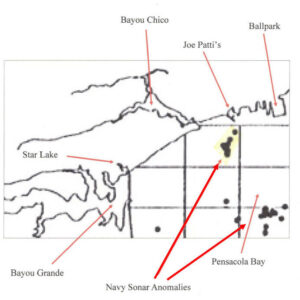
Figure 5: Underwater anomalies identified by the United States Navy off the mouth of Bayou Chico.
In the late 1990s Naval Reserve officer and Pensacola historian Wesley Odom worked with Vice Admiral John H. Fetterman Jr. to conduct an underwater survey of Pensacola Bay as part of a military exercise utilizing one of the Navy’s mine sweepers equipped with the latest underwater remote sensing technology (personal communication, David Dodson, 2024).
The survey was highly successful, producing numerous underwater anomalies located with side scan sonar and magnetometers. The results revealed many underwater anomalies in the lower portion of the bay. Anomalies were located off the mouth of Bayou Chico but were not ground truthed, that is, no divers were sent down to identify the objects. We know underwater anomalies exist there. We do not know what they are. CAI plans to answer the question. Could the objects be related to the expeditions of Galvez, Jackson, or even Luna?

Figure 6: Images of CAI field team conducting aquatic surveys on Bayou Chico.CAI conducted a preliminary side scan survey to relocate the anomalies thanks to donated boats and people volunteering their time. We need to relocate precisely the underwater anomalies and put
divers in the water to identify the anomalies which could date from the 1500s to the early 1900s or even modern times.
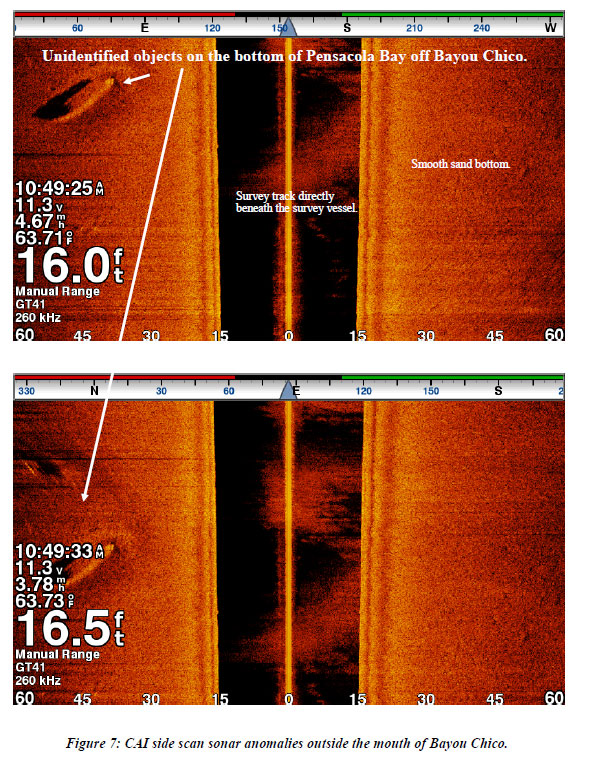
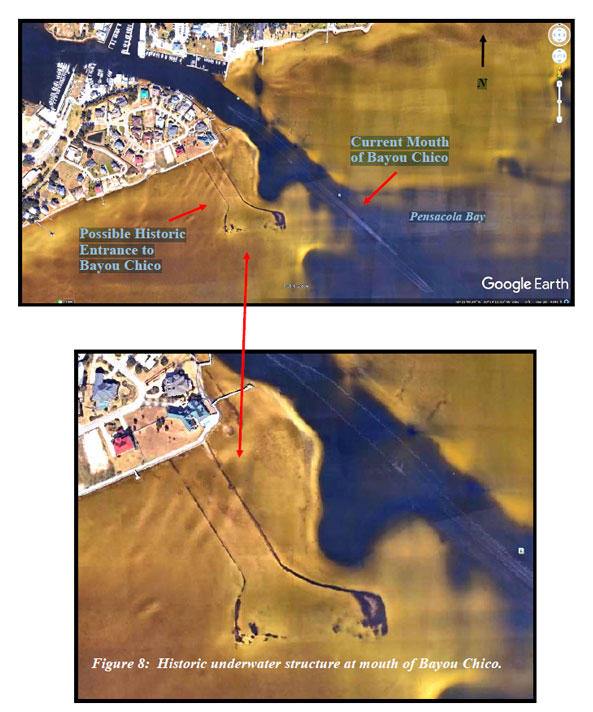
CAI located an underwater anomaly on the west side of the mouth of Bayou Chico. The discovery was made using a rather low tech approach. The field team was traveling at a rapid pace in their boat. The lower unit of the outboard motor struck the anomaly hard. We returned the next day and dove the anomaly with snorkels. The anomaly was comprised of underwater pilings and stone which might be an historic entrance to the bayou.
The images above show the location of the anomaly. Note that the anomaly appears to stop at the shoreline, however, the recent residential high end development was built on dredged deposited sand atop the northern portion of the anomaly. The channel anomaly probably extended into the bayou. At this time the results are inconclusive.
The Industrial Area of Middle Bayou Chico

Industrial area of Bayou Chico.
Industrial areas were established on Bayou Chico from the early 1900s to the present. A partial list of the industries are listed on the above maps. The land was certainly altered by their activities. For example, when construction of the Pensacola Shipyard began in 1918 numerous prehistoric artifacts were reported including three prehistoric skeletons. The previous industrial activities definitely altered the landscape, however, there are many other residential areas that have had moderate impacts, thus are available for archeological exploration.
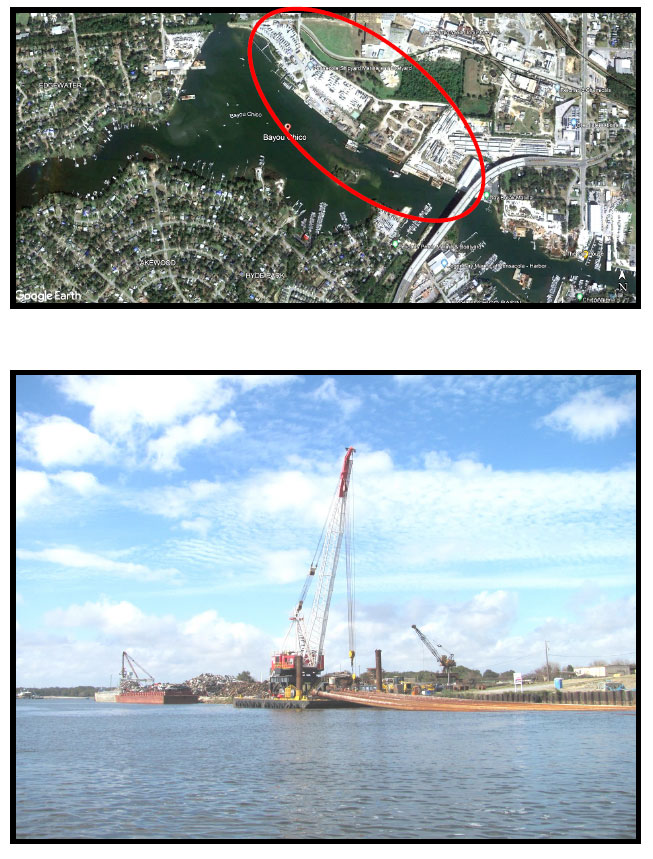
Satellite map and photo of industrial area of Bayou Chico.
The upper illustration is the location of the major industrial area of the middle section of Bayou Chico. The lower illustration is a detail of the industrial area, in this case the metal scrapyard. The following pages focus on the much less impacted area of the northern area of Bayou Chico. Much of the area is residential in nature.
The Northern Area of Bayou Chico
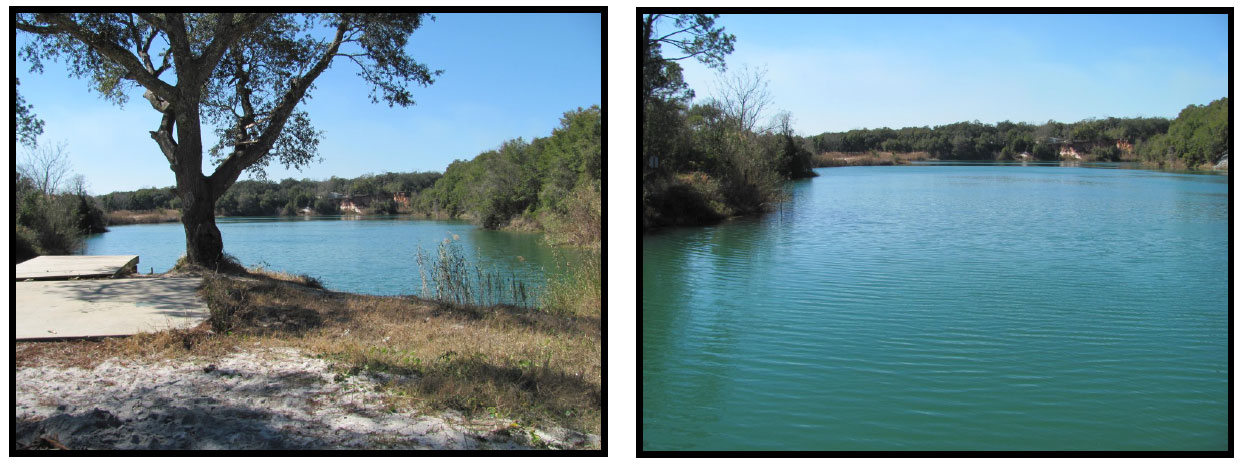
Figure 11: View of the northern headwaters of Bayou Chico showing a spring fed freshwater lake. A commercial company mined sand and gravel from the area and created the spring fed lake during the mid-1900s.
Today, there are remnants of springs located at the base of the marine terrace on the northern portion of Bayou Chico which existed during the early 1800s and 1700s and likely during the 1500s. The water drawn by modern populations has reduced the flow of the aquifer containing freshwater.
It took a substantial amount of water to maintain a large military presence such as Jackson’s, Galvez’s, and Luna’s. Besides the water needed for the people of the historic armies there was need of water for the animals as well. For instance, a horse needs ten to fifteen gallons per day to remain heathy.
Galvez, Jackson, and Luna had thousands of people in their armies as well as horses. They had to have enormous amounts of freshwater to survive. The springs on Bayou Chico could have provided that amount of necessary water. It is one of the few areas in the Pensacola Bay area that could provide that amount of water (see Hydrology of Pensacola’s Springs by William L. Merrill, P.E. Merrill Engineering Inc. in Archeology Ink, An Online Journal, August, 2023).

Figure 12: View of the northern headwaters of Bayou Chico showing the remnants of one of the numerous springs present historically.
Excavations and artifacts, Bayou Chico

Figure 13: Scenes of excavations and samples of artifacts recovered during the Bayou Chico archeological project. Analysis to be included in our planned technical report.
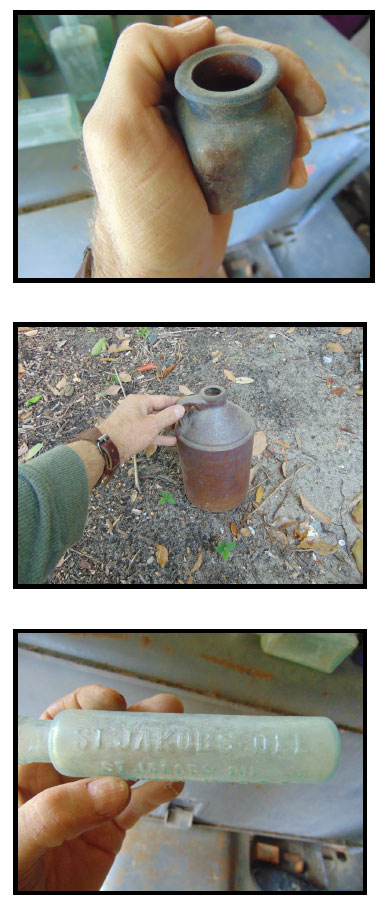
Figure 14: Sample of artifacts recovered during the Bayou Chico archeological project. Analysis to be included in our planned technical report.
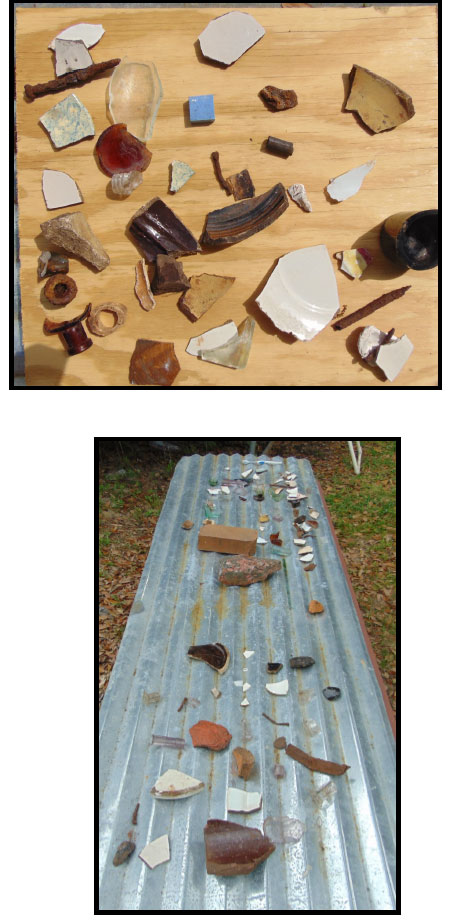
Figure 15: Sample of artifacts recovered during the Bayou Chico archeological project.
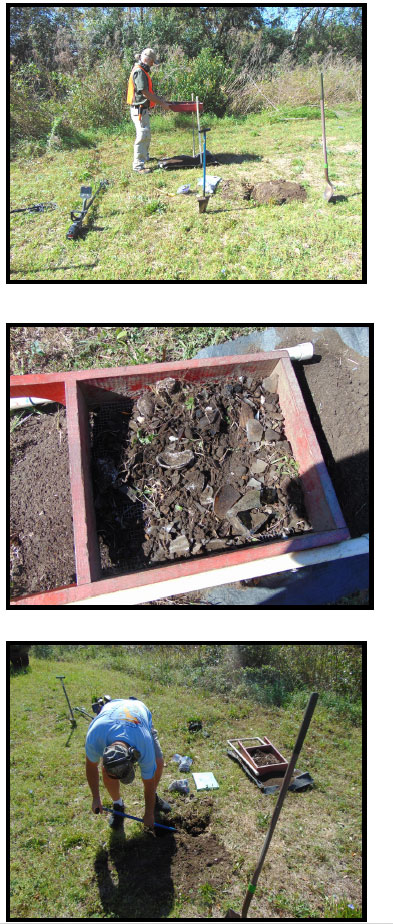
Figure 16: CAI excavations on Bayou Chico.
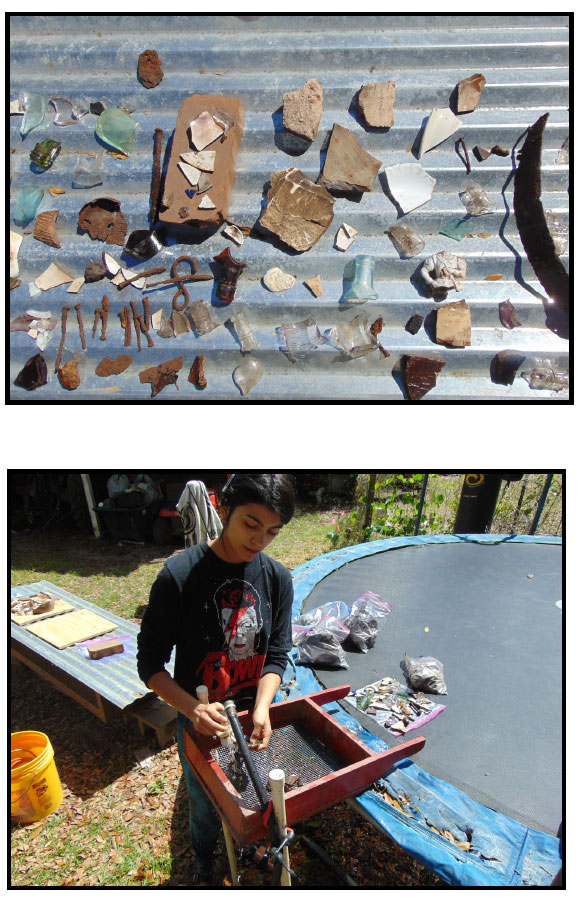
Figure 17: Cleaning and drying artifacts for analysis.

Figure 18: Artifacts for analysis.
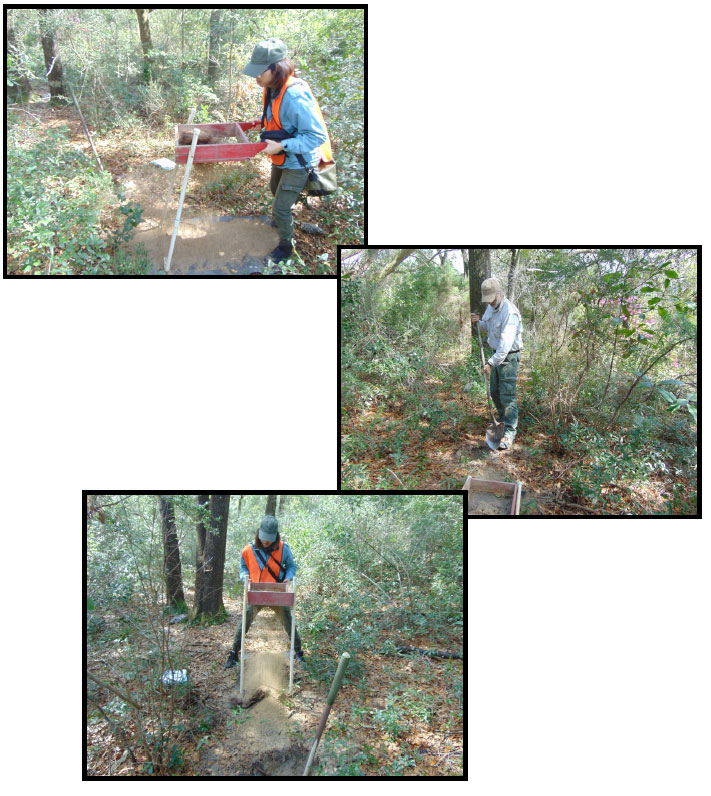
Figure 19: CAI excavations in progress.
Summary, Results, and Research Plans
Bayou Chico is one of most important archeological areas in all of the Pensacola Bay region. The prehistoric period is relatively sparsely represented, however, sites from the historic periods of the late 1700s, early 1800s, and early to middle 1900s are abundant. The current focus of the archeological investigations of Contact Archeology Inc. (CAI) is to more specifically locate the encampments of Spanish General Bernardo de Galvez of the late 1700s and American General Andrew Jackson in the early 1800s.
Galvez and his army, at least 7,000 strong, encamped on Bayou Chico in his successful bid to retake Pensacola from the British in 1781 during the American Revolution. It turned out to be the longest siege of the American Revolution (Odom 2021).
In 1814 American General Andrew Jackson with his army of some 3,000 camped on Bayou Chico during his attack on the combined forces of the Spanish, British, and Creek warriors occupying Pensacola. Eventually Jackson forced his enemies to retreat and Pensacola came under American dominion.
It should also be noted that the archeology of another historic expedition is being considered by CAI relative to Bayou Chico. It is the 1559 Spanish expedition led by Tristan de Luna. The University of West Florida (UWF) claims to have found the Luna Settlement on Bayou Texar northeast of Bayou Chico, however, the necessary archeological features and anchored shipwrecks that would prove the location of the settlement are lacking. That leaves Bayou Chico as a candidate for the settlement. Very little archeological research has been conducted on the bayou relative to that expedition.
This document is not a technical report of the history and archeology of Bayou Chico. It is to be considered an overview of the research. It is necessary to conduct more excavations, artifact analysis, and summarize past and current research in the bayou area to better understand “The finest jewel possessed by his Majesty.”
A Sample of Related Documents
Baker, Henry A., 1975
Archaeological Investigations at Fort George, Pensacola, Florida. Miscellaneous Project Report Series 34. Bureau of Historic Sites and Properties, Department of State. Tallahassee.
Bense, Judith A. and Deborah Joy, 1986
Archaeological Survey and Description of City-Owned Property, Pensacola, Florida. Submitted to the City of Pensacola. Report on file at the Pensacola Planning Department.
Coker, William S. and Robert R. Rea (eds)., 1982
Anglo-Spanish Confrontation on the Gulf Coast During the American Revolution. Pensacola Gulf Coast History and Humanities Conference.
Coker, William S., 1971
Andrew Jackson, The Spanish Floridas and the United States. (in) Andrew Jackson and Pensacola. James R. McGovern (ed).Jackson Day Sesquicentennial Commission. Pensacola.
Coleman, James C. and Irene S. Coleman, 1982
Guardians on the Gulf: Pensacola Fortifications, 1698-1980. Pensacola Historical Society. Pensacola.
Curren, Caleb and David Dodson, 2017
The Spanish King’s Finest Jewel: Bayou Chico on the Bay of Pensacola. Archeology Ink., An Online Research Journal (archeologyink.com).
Curren, Caleb, 1994
The Search for Santa Maria, a 1559 Spanish Colony on the Northern Florida Coast. Pensacola Archeology Lab. Pensacola.
Curren, Caleb, 2022
The Bayou Chico Archeological Research Project: A Plan to Study the Early History of a Portion of
Pensacola Bay, Florida. Archeology Ink., An Online Research Journal (archeologyink.com).
Curren, Caleb, 2021
The 1559 Luna Anchorage? A search off Bayou Chico in Pensacola, Florida. Archeology Ink., An Online Research Journal (archeologyink.com).
Curren, Caleb, 2018
The 1559 Anchorage of the Spanish Luna Fleet in Pensacola Bay. Archeology Ink., An Online Research Journal (archeologyink.com).
Dodson, David B., 2021
Fact, Fiction, or Fraud? The University of West Florida and the “Irrefutable” 1559 Luna Settlement. Archeology Ink., An Online Research Journal (archeologyink.com).
Dodson, David B., 2021
The Joy and Perils of Historical Research: A Short Story of Searching Out the 1559 Luna Expedition to la Florida. Archeology Ink., An Online Research Journal (archeologyink.com).
Dodson, David B., 2017
A Peer Review of the University of West Florida’s Luna Expedition Project—2015-2020. Archeology Ink., An Online Research Journal (archeologyink.com).
Dodson, David B., 2017
The Untold Origins of the Luna Expedition: The Grand Strategy of Philip II and His Council To Secure the Indies, 1556-1559. Archeology Ink., An Online Research Journal (archeologyink.com).
Elking, MaxVon, 1893
The German Allied Troops in the North American ar for Independence 1776-1783. Translated by J.G. Rosengarten. Joel Munsell’s and Sons Publishers. Albany New York.
Farmar, Robert, 1860
Robert Farmer’s Journal of the Siege of Pensacola. Historical Magazine.
Fay, Stanley, 1941
The Spanish and British Fortifications at Pensacola, 1698-1821. Florida Historical Quarterly 20 (3).
Johnson, Cecil, 1971
British West Florida 1763-1783. Archon Books. Yale.
Johnson, Cecil, 1959
Pensacola in the British Period: Summary and Significance. Florida Historical Quarterly 37.
Mckenzie, C.L., 1986
Pensacola Archaeological Survey: Perry-Runyan Site (8Es1333). Unpublished student paper. Ms. On file. Institute of West Florida Archaeology. University of West Florida.
Montemayor, E.A. (translation), 1978
YO SOLO: The Battle Journal of Bernardo de Galvez During the American Revolution. Polanthos. New Orleans.
Odom, Wesley S., 2021
The Longest Siege of the American Revolution. Privately Published.
Padgett, James A. (ed.), 1943
Bernardo de Galvez Siege of Pensacola in 1781. Louisiana Historical Quarterly 26. New Orleans.
Rea, Robert A., 1974
Pensacola Under the British (1763-1781). (in) Colonial Pensacola. (ed) James McGovern.
Reparaz, Carmen de Alone, 1993
1993 Bernardo de Galvez and the taking of Pensacola. Ediciones del Serbal S.S.. Madrid.
Romans, Bernard, 1962
A Concise Natural History of East and West Florida. University of Florida Press. Gainesville.
Rush, N. Orwin, 1981
Spain’s Final Triumph Over Great Britain in the Gulf of Mexico: The Battle of Pensacola March 9 to May 8, 1781. Florida’s Classic Library. Port Salerno.
Rush, N. Orwin, 1966
The Battle of Pensacola: Spain’s Final Triumph Over Great Britain in the Gulf of Mexico. Florida State University Studies Number Forty-Eight. Tallahassee.
Sapp, Jerry W. II, 1986
Archaeology Field School Report on the Bayou Chico Bayfront. Unpublished student paper. Ms. on file Institute of the West Florida Archaeology. University of West Florida.
Salthouse, Clare, 1986
Archaeological Investigations of the Pensacola Shipbuilding Company. Unpublished student paper. Ms. on file Institute of West Florida Archaeology. University of West Florida.
Simmons, Bgen Edwin H. USMC (Ret), 1987
Bernardo de Galvez: The Amphibious Conquistador. Fortitudine, vol. 27.
Stark, Robin, 1986
Archaeological Laboratory Report of Pensacola Shipbuilding Company. Unpublished student paper. Ms. on file Institute of West Florida Archaeology. University of West Florida.
Taylor, Robert A., 1986
Report of Archaeological Fieldwork at the Hargis Hospital Site (8Es1305). Unpublished student paper. Ms. On file institute of West Florida Archaeology. University of West Florida.
Toy, Laurel, 1986
Report of Archaeological Fieldwork at the Hargis Hospital Site (8Es1305). Unpublished student paper. Ms. on file, Institute of West Florida Archaeology. University of West Florida.
Worcester, Donald E (translator), 1951
Miranda’s Diary of the Siege of Pensacola, 1781. Florida Historical Quarterly.
Acknowledgements
A research project such as this cannot be conducted without the help of local people willing to allow us access to their properties, donations of research funds, providing us access to their private collections, sharing their knowledge of the Bayou Chico area, professionals providing their expertise, volunteers donating their time and equipment … and encouraging us to continue our research on Bayou Chico. The following are people who are contributing to this endeavor.
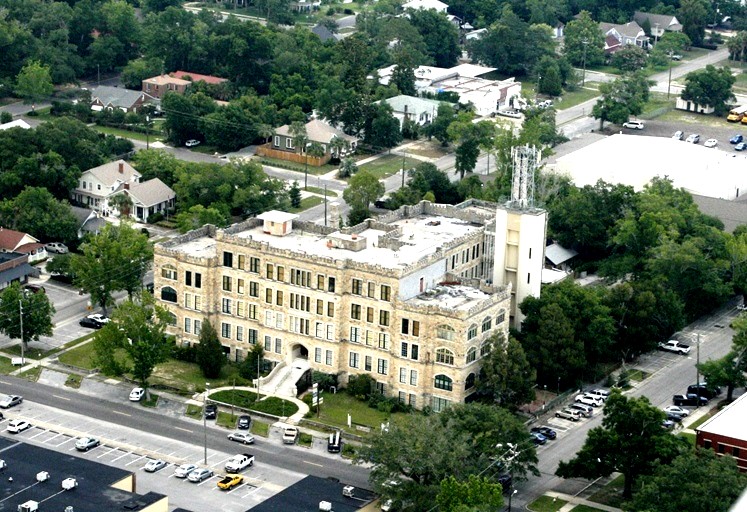
Headquarters of Contact Archeology Inc. in a Portion of the
Historic Sacred Heart Hospital.
- Contact Archeology Inc.
- Caleb Curren: President / Chief Archeologist
- David Dodson: Vice President / Chief Historian Pamela Corey: Editor / Researcher
- Bill Overman: Treasurer
- Shawn Enfinger: Field Supervisor
- Tiffany Miller: Lab Supervisor Maya Enfinger: Photographer
- Joe Engstrom: Metal Detecting Specialist
- Michael O’Donovan: Videographer / Drone Pilot Ned Jenkins: Consultant Archeologist
- Keith Little: Consultant Archeologist
- Rachel Lavelle: Webmaster
Local Supporters, Property Access Permission:
- Frank Patti, Senior
- Pensacola Shipyard Terry Berling
- Collier Merrill
- Pensacola Yacht Club
- Armstrong World Industries, Pensacola Escambia County, Florida
- Lamar Brazwell Joey Brazwell
- Jolly Sailing and Dolphin Cruises Parker Automotive
- Captain Sidney Clopton Perry-Runyon Property
Local Sources of Historical Data:
- Wesley Odom
- David Dodson Frank Patti Jr. Frank Patti Sr. Steve Ritz
- William Merrill Terry Berling
- Rosemary Sanders
Funding:
- Wesley Odom David Dodson Frank Patti, Jr.
- Pensacola Metal Detector Club Tower East